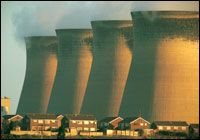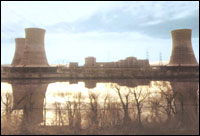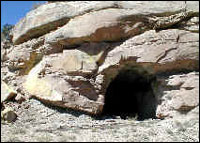It’s a long-held tenet of U.S. environmentalists that nuclear power is bad news. Critics argue that the clean-air benefits of nuclear reactors are far outweighed by the consequences of uranium mining and radioactive waste storage — not to mention the damage that could result from an accident at an atomic power station. Now more than ever, with growing concern about terrorist attacks on nuclear plants, this energy source simply doesn’t seem to be worth the risk.

Nuclear and present danger?
And yet, nuclear plants currently generate 20 percent of U.S. electricity. Whether we like it or not, removing that supply and replacing it with cost-competitive fossil-fuel-based power plants (the alternative that, realistically, most utilities would choose) would result in a significant decrease in air quality and a significant increase in greenhouse gas emissions — the equivalent of adding 100 million cars to the road, according to the Nuclear Energy Institute.
Though critics argue that this estimate is grossly inflated and point to the hidden emissions associated with mining and milling uranium, there’s no disputing that nuclear power plants significantly offset carbon dioxide (CO2) emissions. “In many ways the debate over nuclear has been a dialog of the deaf — one side arguing, incorrectly, that nuclear does not significantly offset CO2 emissions, and the other arguing that these offsets make it altogether environmentally virtuous,” said Arjun Makhijani, president of the Institute for Energy and Environmental Research. “The environmental effects of nuclear and energy sources such as coal are simply not commensurable. When you consider the routine waste and [water] pollution the nuclear industry produces in its mining and milling process, not to mention the risk of accident that could devastate entire cities, and potential proliferation problems, the CO2 offset advantages of this industry are essentially moot.”
The trouble is, it’s entirely unrealistic to imagine taking all nuke plants in the U.S. offline anytime soon. (“This would be like arguing that we should tell all Americans to stop driving their cars tomorrow in order to prevent global warming,” says Makhijani.) But that’s no reason not to start thinking about how to phase out nuclear power. Makhijani has developed a compelling proposal to eliminate U.S. dependence on nuclear power over the next 50 years and, over that same period, reduce CO2 emissions by 50 percent through efficiency programs and the replacement of aging coal-fired plants with far more efficient natural gas plants and cost-competitive renewable energy.
2010 Vision
Now is the time to advocate such a plan, as the Bush administration advances its wars on terrorism and Iraq. A central premise of the Iraqi incursion, after all, is to preempt Saddam Hussein’s alleged efforts to build nuclear weapons. Meanwhile, the U.S. has a raft of nuclear reactors on its own shores — 103 of them, to be exact — many of which have proven vulnerable to sabotage. A staggering 47 percent flunked mock-terrorist attacks simulated by the Nuclear Regulatory Commission between 1991 and 2001, even after their operators were given six months to prepare for the tests. Security has been tightened considerably since Sept. 11, but nuclear engineers at organizations including the Nuclear Control Institute, the Natural Resources Defense Council, and the U.S. Public Interest Research Group maintain that many of these plants are still at risk of becoming weapons of mass destruction — weapons that would, needless to say, do more human and environmental harm than virtually any other threat imaginable.

New York’s Indian Point
nuclear power plant.
Photo: New York Power Authority.
But neither this security imbroglio nor the potentially severe environmental consequences of uranium mining and nuclear waste storage has dissuaded the Bush administration from promoting expanded nuclear power in both its energy and environmental policy. “Forcefully declaring [in the administration’s energy plan] that nuclear power should be part of the world’s fuel mix took some people by surprise, but to us it was just common sense,” said Energy Secretary Spencer Abraham last August, while speaking to industry leaders at a World Nuclear Association luncheon. “Nuclear power today is safer than ever, more reliable than ever, less expensive than ever, and it is absolutely vital for our future.”
In October 2002, the Bush administration proposed the “Nuclear Power 2010” program to get the industry rolling again after three decades during which no nuclear plants were constructed due to financial and health risks. The plan aims to identify new sites for nuclear plant construction, streamline regulations that govern the site-licensing process, extend the legal lifespan of aging nuclear power plants that otherwise would have to be mothballed in the next decade, and entice the private sector to begin constructing new nuclear plants by 2005 and complete them by 2010. The Bush administration recently proposed a $388 million budget in fiscal year 2004 for nuclear research and development (a marked departure from the Clinton era, during most of which the nuclear R&D budget was zero) and established nuclear as a key component of its new “FreedomFUEL” plan — promoting it as a “sustainable” and “emissions-free” way of powering hydrogen production in the future.
In defending nuclear power, Bush administration officials have sung the praises of new “Generation 4” nuclear technology that they argue is cheap and safe — but across the board, environmentalists say this is bogus. “They argue we’ll build a proliferation-proof reactor. This doesn’t exist,” said Makhijani. If anything, he says, Gen-4 technology is even more disaster-prone, because many of the models recycle spent uranium as a cost-saving measure — but spent uranium contains plutonium that could be used in weapons.
From a cost perspective, it’s true that the average price of electricity from nuclear plants is a trifling 1.7 cents per kilowatt-hour — even cheaper than coal’s average of 2 cents per kWh. But environmentalists argue that this price tag doesn’t take into account the exorbitant costs of risk insurance from which the feds shield nuclear companies. While the accident liability of a nuclear utility is capped at $9 billion, for instance, the potential damages from an accident at the Indian Point nuclear plant, just outside New York City, are estimated at over $200 billion. “Nuclear power is by far the most expensive source of energy. It’s dirty, it’s dangerous, and it generates waste for which there is no sound or sane management strategy,” says Anna Aurilioa, a senior nuclear analyst at U.S. PIRG. “If the federal government forced the nuclear industry to pay the full cost of the risk that their plants pose to the public and the environment, every one of them would be shut down, forever.”
Like Ike?
The first power station to produce electricity from the heat generated by splitting uranium atoms began operating in 1957, four years after President Eisenhower unveiled the “Atoms for Peace” program and directed the Atomic Energy Commission to begin adapting nuclear power for non-military uses. Eisenhower wanted to move nuclear science “out of the dark chamber of horrors into the light,” as he put it.

Three Mile Island.
Photo: U.S. Energy Department.
Up until the late 1970s, many environmental groups, including the Sierra Club, heralded nuclear power as an emissions-free energy source. That cheery outlook came to an abrupt end in 1979, when equipment failures and human error caused the worst nuclear accident in U.S. history, at Three Mile Island near Harrisburg, Penn. Throughout the 1980s, medical reports linked cancer incidence to radiation exposure at nuclear power plants and in underground uranium mines. Then came 1986 and the darkest days of the nuclear industry, when the notorious Chernobyl meltdown exposed 75,000 people to high-level nuclear radiation. Such events made the licensing of new nuclear plants nearly impossible in the United States, because no communities wanted them built in their backyards and no investors wanted to face the high operating costs and the possibility of disaster.
Today, however, in light of the Bush administration’s renewed support for nuclear, the spiking costs of natural gas and oil, and the increased pressure on countries worldwide to reduce greenhouse gas emissions, the nuclear power industry is “anticipating a significant renaissance,” says Vaughn Gilbert, a spokesperson for Westinghouse Electric Co., one of the world’s largest manufacturers of nuclear power plants. “Investors and politicians are realizing that nuclear will play a key role in helping America wean itself off of fossil fuels, and become the foundation of a clean, sustainable future,” agreed Steve Kerekes of the Nuclear Energy Institute.
But critics say that the idea of nuclear power as the foundation of a sustainable future is a pipedream. First, they note, the very notion that nuclear is emissions-free is a fiction. Although the reactors themselves emit no greenhouse gases, sulfur, or nitrogen oxides, the process of mining, enriching, packaging, and transporting uranium certainly does. In fact, the enrichment process is so energy-intensive that when nuclear power plants were proliferating in this country in the late 1950s, new coal-burning plants were constructed for the sole purpose of powering the nuclear enrichment stations. A May 2001 article in Mother Jones, “Nuking the Atmosphere” by Mark Francis Cohen, cites an estimate by Christopher Sherry, research director for the Washington, D.C.-based Safe Energy Communication Council, that all told, uranium enrichment in the U.S. currently generates about 14 million tons of CO2 annually.
The nuclear industry, however, points out that each year, U.S. nuclear power plants prevent the emission of 164 million tons of carbon, 5.1 million tons of sulfur dioxide, and 2.4 million tons of nitrogen oxides. Notwithstanding the carbon emissions associated with uranium enrichment, there’s no denying that the net reduction of greenhouse gases per year as a result of nuclear energy is substantial.
But the side effects of uranium mining go well beyond hidden carbon emissions. Harvesting usable uranium is an incredibly wasteful process. On average, for every 1,000 tons of uranium ore that are extracted, you get only 50 tons of usable uranium. Meanwhile, much of the waste is left behind in toxic slag heaps.

An abandoned uranium mine
on Navajo land.
Ninety percent of the uranium consumed by the U.S. is imported, largely from Canada and Australia, which have high-grade ore deposits. The majority of uranium mined in the U.S. comes from Native American reservations in the West, which are largely exempted from environmental regulations. The miners on these reservations have alarming lung-cancer rates from inhaling radon-tainted dust, and the toxic tailings piles at abandoned mines have been used unwittingly for building materials or have scattered into the air.
In order to address the dust and erosion problems caused by open-pit and underground mining, the nuclear industry developed “in-situ mining,” which involves dropping a well deep into the ore-bearing portion of an aquifer and pumping in a chemical solution that dissolves heavy metals from rock. The “pregnant solution” is then retrieved and the uranium is distilled from it. “While it often does much less in the way of land erosion, this method leaves these areas with contaminated aquifers, whose radioactive waters can kill the animals and plants that consume them,” says Geoff Fettus, a nuclear engineer at NRDC.
Glow with the Flow
Even more alarming from an environmental standpoint is nuclear waste disposal. Used uranium rods remain “hot” (radioactive) for between 10,000 and 250,000 years. “Scientists have absolutely no idea about how we can contain these radioactive materials for that long a time,” says David Lochbaum, a nuclear engineer with the Union of Concerned Scientists. “A country 200 years old is facing a mighty big problem when it’s creating waste that must be isolated from the environment for at least 10,000 years. Scientists simply don’t have enough evidence to know what the effects will be down the road.”

Yucca Mountain.
Photo: U.S. Department of Energy.
After uranium is burned, the rods are kept in pools of water at the plant for five to 10 years until they’re cool enough to be sealed in concrete and steel containers and stowed underground. (Many plants keep their waste in holding pools for decades without transferring them to containers — a cheaper but far more hazardous storage option.) However, the containers themselves won’t last for more than several hundred years, which is why Yucca Mountain, Nev., has been proposed as a geologically isolated long-term sarcophagus for nuclear waste. Since 1982, over $50 billion has been poured into researching the geological suitability of Yucca Mountain for such purposes. Environmentalists argue that the choice of Yucca Mountain has been based more on political convenience than environmental suitability, and that too little time has been spent evaluating the possible radioactive contamination of the aquifer beneath the site.
Environmentalists are also concerned about the transportation of spent uranium to Yucca Mountain. The Department of Energy has admitted that any human standing within two yards of storage tanks for an hour will be exposed to radiation levels equivalent to a chest x-ray, which can be dangerous for pregnant women. “What if you’re stuck in traffic next to one of these trucks carrying nuclear waste?” asks U.S. PIRG’s Aurilio. The nuclear energy industry argues that these concerns are exaggerated. “This volume of waste is absolutely manageable,” says Thelma Wiggins of the Nuclear Energy Institute. “All told, over the last 40 years, the waste fills an area no bigger than a football field that goes five yards deep.”
Great Britain, which has amassed less nuclear waste than the U.S., doesn’t agree that there’s nothing to worry about. Most of Britain’s nuclear plants, which account for a whopping 30 percent of the country’s energy supply, are scheduled to reach the end of their legal lifespans within the next decade. And yet the British Parliament voted last year to block the industry’s effort to expand the life of the plants or allow new ones to be built. Instead, it is launching a phase-out campaign much like the one proposed by Makhijani: increasing natural gas production, improving energy efficiency by creating incentives for green buildings and energy-efficient companies, and increasing investments in alternative energy resources such as solar and wind.
If it is true that “national security” and “preemptive measures” are the paramount concerns of the Bush administration, we would do well to follow the British example. Better to begin ridding our own soil of weapons-in-waiting than to wage war overseas to prevent the proliferation of those that haven’t yet been made.

